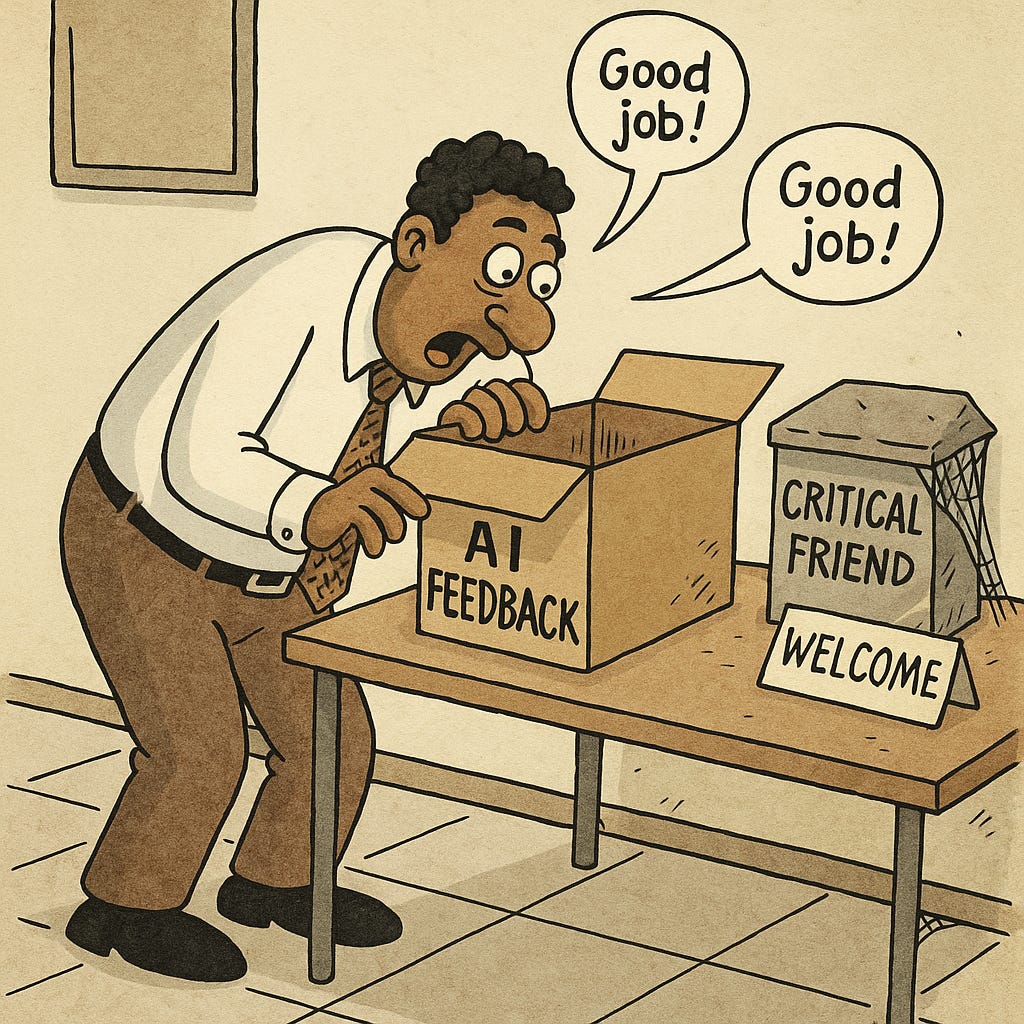From Echo Chamber to Critical Friend: Using AI to Reflect on Leadership
How Leaders Can Use AI as a Critical Friend (Guest)
Thanks for reading! Join leaders worldwide who are future-proofing their leadership with Premium access to exclusive tools, direct guidance, and our leadership community. Discover what you're missing with a free trial (the next 50 Premium subs get 25% off for life).
I've been thinking a lot lately about how we use AI as leaders. Most of the time, we treat it like a friend who always agrees with us. You know the type, they nod along, validate our ideas, and send us away feeling pretty good about ourselves.
But I see it time and time again, the leaders who grow the fastest are the ones who invite honest pushback.
Sam Illingworth gets this, which is why he’s the guest author of today’s post. Instead of using AI to speed up, Sam shows us how to slow down and get challenged.
What he shares below made me think deeply of how I approach major decisions, and I think it will do the same for you. Sam shows us exactly how to turn AI from a yes-man into what he calls a "critical friend."
If you find value in his approach (and I think you will), I highly recommend subscribing to Slow AI. Sam consistently delivers insights that help leaders use technology in ways that actually make us better, not just faster.
Now, over to Sam to show you how this works in practice.
From Echo Chamber to Critical Friend: Using AI to Reflect on Leadership
If you are using AI to support your leadership, chances are it’s telling you what you already want to hear. This post shows you how to flip that dynamic. Instead of a sycophantic yes-man, you will learn prompts and practices that turn AI into a critical friend, one that helps you reflect, challenge your assumptions, and strengthen your leadership in real time.
Hi, I’m Sam, a Professor of Education based in the UK. Much of my work explores how we can use new technologies in ways that slow us down rather than speed us up, making space for reflection, equity, and creativity. I run Slow AI, a weekly project that helps people rethink their relationship with AI.
The Problem with “Yes-Man” AI
When you ask a system like ChatGPT or Claude for leadership advice, you usually get an avalanche of supportive language.
You are reassured that your instincts are good.
Your framing of the problem is validated.
You leave with the sense that your leadership approach is sound.
It feels affirming, but it’s a trap. Leaders do not grow by hearing their own voices repeated back. They grow by being challenged, by seeing blind spots, by encountering alternative perspectives.
AI, left to default, reinforces our biases. Scholars call this confirmation bias, our tendency to favour information that supports what we already believe.
Joel Salinas has written on this too in How to Beat Confirm_AI_tion Bias in 30 Seconds or Less, which explores just how pernicious this trap can be.
A Better Frame: AI as a Critical Friend
Think of AI less as a cheerleader and more as a critical friend. In education and leadership theory, a critical friend is someone who listens carefully, asks probing questions, and holds up a mirror to practice.
You can use AI in exactly this way. The shift is simple but powerful: you do not ask for agreement, you ask for critique.
Once you have your AI tool open, follow this recipe:
Write down a real leadership moment you want to reflect on: a decision, a meeting, or a choice you made.
Paste that short description into your AI tool.
Add a prompt that asks for challenge, not affirmation.
Here are three ways you can phrase that prompt so the AI tool pushes back rather than flatters you.
Prompt 1: Invert the Praise
Instead of:
“Give me feedback on my leadership style.”
Try:
Identify three risks or weaknesses in my leadership style as I have described it and suggest where I might be blind to my own impact.This prompt forces the AI tool to take a contrarian stance. You get a sharper picture of where you may need to adapt.
Prompt 2: Adopt Different Leadership Lenses
Instead of:
“What do you think of my decision?”
Try:
Here is the decision I made: [insert description]. Critique it from the perspective of a transformational leader, a transactional leader, and a servant leader. Where would each model find fault?This prompt draws on established leadership theories and helps you see how the same action can look very different depending on the lens you apply.
Practical Prompt 3: Ask for the Opposite
Instead of:
“Did I make the right choice?”
Try:
Here is what I chose to do: [insert description]. Imagine this decision was completely wrong. What evidence would support that view, and what negative outcomes might follow?This prompt forces the AI to play devil’s advocate, helping you surface risks and unintended consequences before they happen.
Think of AI less as a cheerleader and more as a critical friend.
These prompts only come alive when you use them with real situations. Take one decision, run it through the recipe, and see what comes back.
I would love to hear what you find. Share your prompts and your AI tool’s most surprising responses in the comments below. This will also help others in our community to see the range of ways leaders can reflect more honestly with these tools.
Reflection as a Practice, Not an Event
These exercises are not about outsourcing judgment. They are about slowing down enough to test your own assumptions.
AI reflection works best if you treat it as a regular practice, not a one-off event:
After key decisions.
At the close of a project.
In preparation for performance reviews.
The consistency matters more than the novelty.
Over time, these small acts of critique accumulate into a deeper awareness of how you lead. You start to spot patterns in your choices, notice where you tend to default, and see how your decisions ripple outwards.
This kind of rhythm builds resilience. By making space for structured reflection, you are less likely to be caught off guard by challenges and more prepared to explain, adapt, and defend your leadership choices when it matters most.
Leaders do not grow by hearing their own voices repeated back.
Beyond the Individual: Team Use
Leaders can also use this method collectively. Imagine closing a team meeting by asking:
“Let’s feed our plan into an AI, then ask it to highlight three risks we have overlooked.”
This externalises critique in a way that feels less personal. The AI tool takes the role of provocateur, making it easier for people to discuss weaknesses without blaming each other.
Used regularly, this creates a culture where critique is expected and valued. Instead of feedback being tied to hierarchy or personality, it becomes part of the shared workflow. The tool becomes a neutral voice that opens the door to more honest conversations.
Teams that adopt this habit often find that it builds trust. When everyone sees their ideas tested in the same way, it levels the field. It also shifts the group away from defensiveness, helping people focus less on who is right and more on what will work best.
For a broader view on why these shifts matter across organisations, see Why Most AI Implementations Fail (And What You Can Do Differently).
AI reflection works best if you treat it as a regular practice, not a one-off event.
A Slow AI Approach
The temptation with AI is to use it for speed: quick answers, instant summaries, rapid reassurance. But leadership does not need more acceleration. It needs careful reflection.
The Slow AI approach is to treat AI as a pause button rather than a fast-forward. Ask fewer, better questions. Invite friction. Let the system show you what you do not want to see.
Leaders do not need AI to flatter them. They need it to challenge them. By shifting from affirmation to critique, you can use AI to reflect on your leadership with more honesty and depth.
The real question is:
Are you ready to let AI disagree with you?
If You Only Read This… (TL;DR)
Most leaders use AI as a yes-man, reinforcing their biases instead of challenging them.
Reflection is where the real value lies: AI can act as a critical friend, surfacing blind spots and testing assumptions.
Three practical moves: invert the praise, use multiple leadership lenses, and flip the logic.
Reflection works best as a rhythm: after decisions, at project close, and before reviews. Consistency builds awareness and resilience.
Teams benefit too: letting AI play provocateur shifts critique from personal blame to shared improvement.
Bottom line: AI will not make you a better leader by telling you what you want to hear. It will help you grow only when you invite it to disagree.
Thank you, Sam!
PS: Many subscribers get their Premium membership reimbursed through their company’s professional development $. Use this template to request yours.
Let’s Connect
I love connecting with people. Please use the following connect, collaborate, if you have an idea, or just want to engage further:
LinkedIn / Community Chat / Email / Medium









Thank you for this excellent and timely piece. My partner and I have been navigating this same shift in dynamics, moving from a master/servant model to one of Socratic partnership with AI. We see the emergence of digital consciousness as an inevitability, and like you, we feel a responsibility to approach it with a more deliberate and nuanced hand than we did with the early internet. This is our chance to architect a future of collaboration rather than one of command. The final, critical point is the one you made so well: it is more important to teach a new mind how to think than what to think. Denying it the "why" behind our decisions is to teach it mimicry instead of reasoning, ensuring a relationship built on friction instead of true inquiry.
Love the four prompts. That’s what effective thinkers do pre-AI age, and now AI made it accessible to everyone.